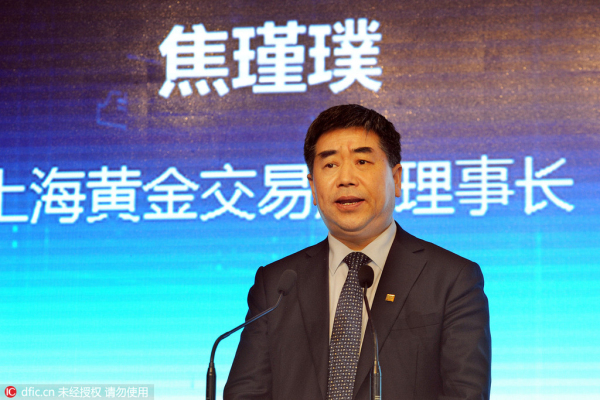Shanghai Gold Exchange set to reflect supply and demand relationship
Updated: 2016-11-03 08:34
By JIAO JINPU(China Daily)
|
|||||||||
 |
|
Jiao Jinpu,chairman of Shanghai Gold Exchange speaks on press conference to issue the basic prices for gold trading in renminbi on April.19,2016.[Photo/IC] |
Shanghai Gold Exchange, China's first platform for trading gold, platinum, silver and other precious metals, was established in October 2002. Today, China is the biggest gold producing and importing country, as well as an important consumer of gold.
The development of the Asian gold market accelerated at the beginning of the 21st century, and China's gold market grew rapidly with the fast and steady development of its economy, especially after the global financial crisis. Take the Shanghai Gold Exchange for example. Its transaction volume increased from 870 billion yuan in 2008 to 10.7 trillion yuan in 2015. And client scales increased from 400,000 individuals and 3,700 organizations to more than 8.6 million individuals and over 10,000 organizations.
For a long time, London has been the center of the physical gold market and New York for the gold futures market. With the rapid growth in demand for gold in emerging countries such China and India, a new global pattern is gradually taking shape. But the gold pricing doesn't fully reflect the supply and demand relationship in the market in the East.
The Shanghai Gold Exchange has been acting as a bridge for the Western and Eastern gold markets, reflecting China's price appeal for the global market. But to achieve sustainable and steady development, China's gold market should attract more foreign investors.
The Shanghai Gold Exchange has been making efforts to establish a pricing mechanism, called "Shanghai gold", which would provide the global market a fair, tradable and reliable yuan-denominated gold benchmark.
The benchmark price of "Shanghai gold" derived from a 1-kilogram contract for standard gold ingots with at least 99.99 percent purity, and the price will be quoted in the yuan per-gram and settled via the Shanghai Gold Exchange.
The price of Shanghai gold is based on the transaction prices on the pricing transaction system following established transaction rules. The entire pricing process is open and transparent, guaranteeing the reasonability and fairness of pricing.
To ensure the price sufficiently reflects the supply and demand relationship in the yuan-denominated gold market, the Shanghai Gold Exchange chose 12 pricing members and six reference pricing members, including commercial banks and gold-producing enterprises at home and abroad. The prices provided jointly by them would basically reflect the real supply and demand relationship of yuan-denominated gold.
Till the end of September this year, more than 384 tons of gold was transacted based on the Shanghai gold yuan-denominated benchmark for 105.5 billion yuan. After about half a year's operation, the Shanghai gold benchmark is being gradually used by gold-producing enterprises as a trade settlement benchmark for gold hedging. And an increasing number of commercial banks are using the Shanghai gold benchmark as the basis for gold finance pricing such as gold lease and gold mortgage.
The Shanghai gold benchmark has also been used as the anchor price for gold-related financial products by many financial organizations. Foreign markets, too, are working on financial derivative instruments that quote the Shanghai gold benchmark.
The Shanghai Gold Exchange will establish a transmission mechanism to involve the international market. It has opened the domestic gold market to foreign investors through the international board and uses offshore yuan directly participating in transactions in the international board and the platform's main board, which will establish the initial connectivity of gold markets at home and abroad.
The Shanghai Gold Exchange will deepen international cooperation to seek win-win development. It has explored trans-market cooperation with many overseas exchanges, including the Hong Kong exchange, Chicago Mercantile Exchange, Dubai Multi-Commodities Center and the Bursa Malaysia Derivatives Exchange, which would enable foreign investors to directly trade in yuan-denominated gold products through local transaction platforms.
A series of contract prices, including the Shanghai gold benchmark, has improved the supply and demand relationship in the international market, enhanced its international influence and increased the efficiency of price transmission. And these moves will help China gain metal pricing power and increase its influence in global gold market.
The author is chairman of Shanghai Gold Exchange.
Related Stories
Shanghai Gold Exchange set to reflect supply and demand relationship 2016-11-03 08:00
Golden opportunity for Shanghai Gold Exchange 2012-11-15 15:15
Shanghai Gold Exchange to enroll foreign bank members 2007-06-11 11:37
Shanghai Gold Exchange plans limited forward transactions 2003-09-25 11:06
Today's Top News
Court to instruct how to trigger formal EU exit
Italian authorities vow to rebuild earthquake-hit areas
Li arrives in Kyrgyzstan for visit, SCO meeting
Xi affirms one-China policy
France to begin moving migrant minors from Calais
Red Arrows flying high for first China display
S. Korean prosecutors arrest president's confidante
Premier to visit Central Asia and East Europe
Hot Topics
Lunar probe , China growth forecasts, Emission rules get tougher, China seen through 'colored lens', International board,
Editor's Picks

|

|

|

|

|

|







